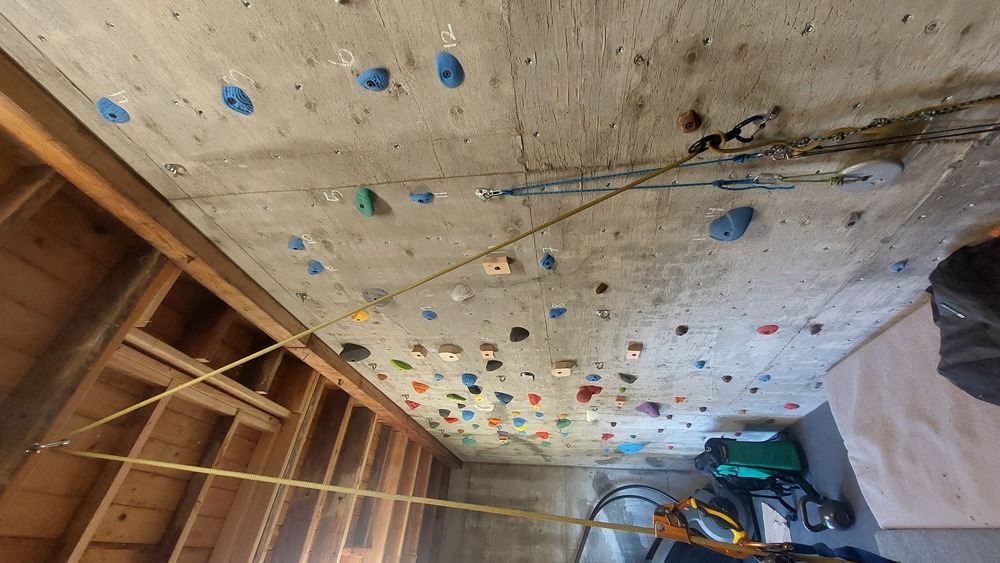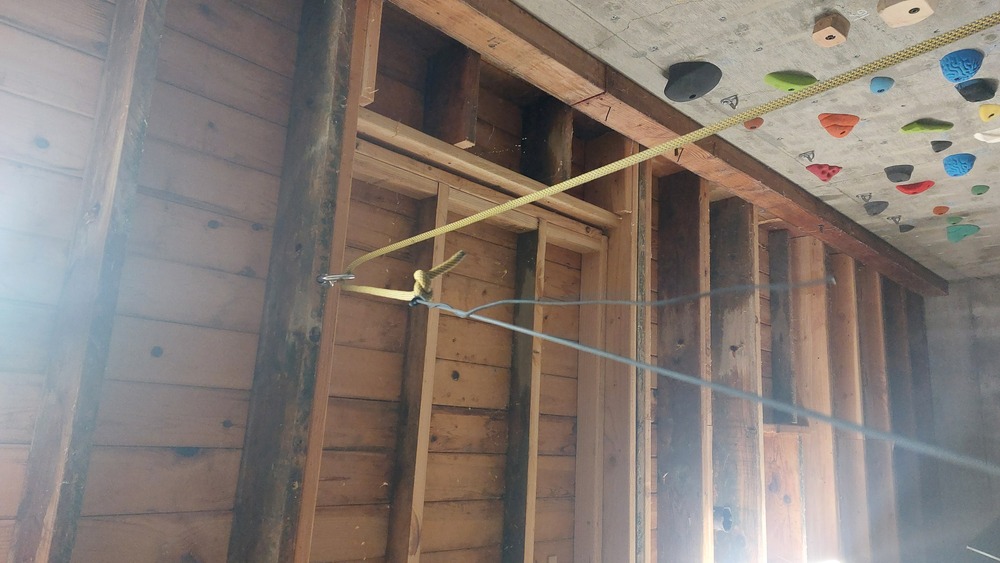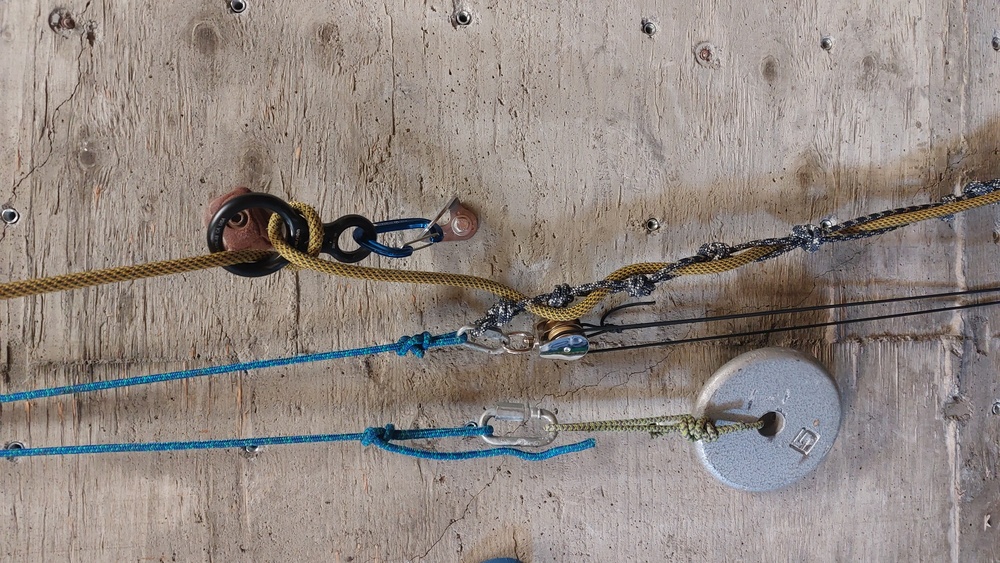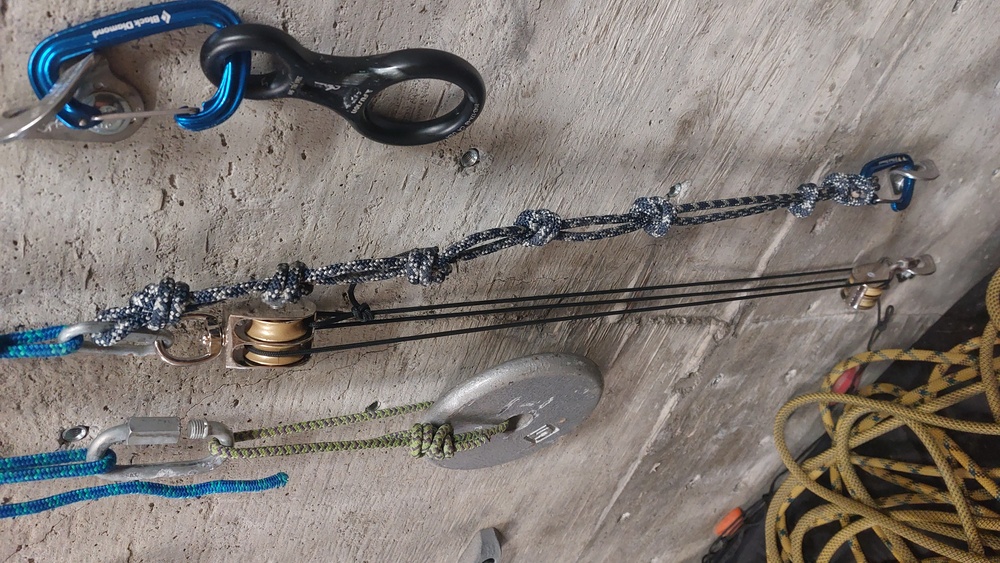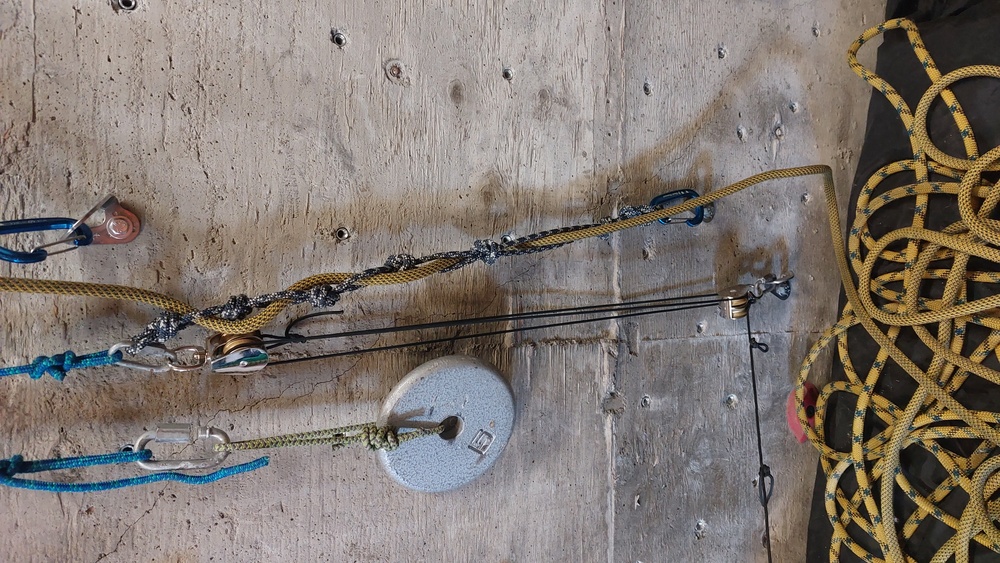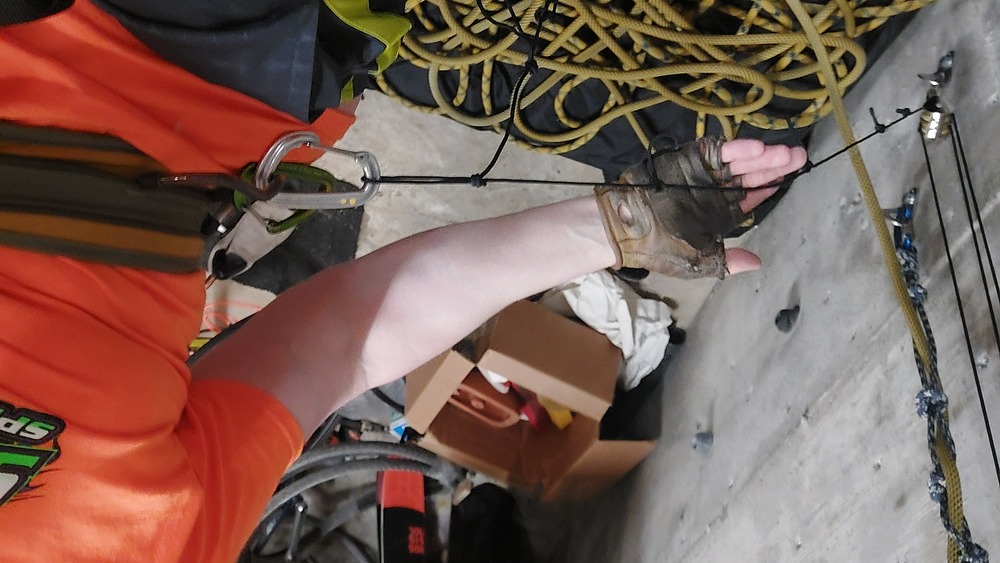Presenting: The Free-Hanging Jumar Treadmill
|
|
Free hanging jumaring... it's tough, it's strenuous, and it's even worse if you're not using good technique. Suboptimal technique will fatigue your arms. I'm sure I'm not the only one who's arrived at a belay only to find his biceps seized, unable to straighten his elbow from cramp. It can also be a difficult technique to practice. 60 meter high, free-hanging spans one can easily set a rope up on aren't all that common. The best way I had heard of to practice was to set up a free-hanging toprope belay, and have your buddy gradually pay you out slack as you jumar the rope. But in such a system, the true rope soloist sees yet another opportunity to replace the hominid on the other end of your line with overcomplicated ropework chicanery. After months of trial and error, I finally present to you... The rope jumaring treadmill automatically pays out an entire length of rope, keeping you (the sweating, heaving, weirdo in his basement) suspended mid-air, never reaching the ceiling, and never lowered all the way to the ground. The vertical strand (the one you attach your jumars to) loops through a carabiner secured to the ceiling. It then passes through a figure of 8 belay device which provides the majority of the friction in a steady, smooth way. The rope then passes through a special friction hitch I devised which modulates the friction, acting as the "brake hand." I tried many different types of friction hitches, but all the ones we typically use in climbing were unsuitable and too finicky, with the applied friction overly dependent on subtle knot dressing details. This ladder-of-loops type friction hitch works consistently, is easy to reset, and easily fine-tuned (just vary the spacing between knots and the number of knots). A block and tackle system (with black paracord) pulls the top of the hitch down, loosening the grip of the "brake hand" and causing slack to pay out. The other end of the black paracord is attached to the climbers harness. As you climb higher, the paracord is pulled and rope slack pays out. As the slack pays out, you drop, and the paracord retracts back into the block and tackle. Friction increases, and then rope stops paying out. Once properly tuned, you find an equilibrium where you're climbing in space as rope automatically feeds out to you. The blue cord with the 5lb weight is required to keep the block and tackle tensioned and makes it properly self-retracting. Once you reach the end of the line (when your safety knot hits the friction hitch, that is), neatly flake the rope, reset the system, and do it again! After climbing many, many lengths of rope, your jumaring technique should improve. You'll find which muscles tend to fatigue early (for me, it was my right bicep) and learn to focus effort from other parts of your body to compensate (for me, it was putting more force into my right foot and left arm when initiating the upwards motion). I run a Texas style ascending setup with my right hand on top btw. You'll also learn how to aerobically pace yourself, and you can get your sling and foot-loop lengths dialed (a critical part of efficient ascending) |
|
|
Brilliant. I have done many pitches on the infinite jumar train with another person lowering and frequently wondered if there was some kind of way (like via a splice) to make such a horrible device. Kudos. |
|
|
Splice your rope ends together and you’ll really be onto something |
|
|
love it. can you put it in reverse to practice passing knots on rappel?? |
|
|
Rob Dillon wrote: Oh trust me, I thought about it. But how do you splice a dynamic kernmantle rope? No way such a splice would feed smoothly through such a system. Also, the loop would probably get all jacked up with twists you could never un-twist. Maybe some non-kermantle rope could be used, but I decided it wasn't worth the effort to make the thing truly continuous. And after jumaring 50 meters, I'm more than fine taking a little break to reset the system; I'm gassed. |
|
|
ilya f wrote: Maybe if you reverse your entropy, Tenet style |
|
|
Thread of the year. High effort, stupid, elaborate, informative, all around 10/10 |
|
|
There is a sort of line designed for diameter-keeping end-for-end splicing. Marlow calls it "MGP Furl" It comes in various diameters, and is actually pretty nice for jugging/rappelling, since it's quite static. A spliced loop of that, and you could treadmill all day as your endurance increases.... |
|
|
Gee, winter sure is tough on wall climbers, huh? This reminds me of Count Rugen's torture cave in the Princess Bride. Sam, do you have six fingers on your right hand by any chance ???? |
|
|
Dude can you make a how to video? This would be sweet |
|
|
Well that is nice and all, but let's see some photos of your free hanging jugging system. You can practise all that you like, but if your system sucks, you're doing too much work. If you want to know how to jug a free hanging rope efficiently, don't ask a climber. Ask a caver. Cavers have nothing better to do with their time than perfect their free hanging jugging systems! |
|
|
I think edelrid, a long time ago, made continuous perlon slings. Off topic, but they also used to make real bicolor ropes. Half red, half white, in 9mm half rope. |
|
|
Here's a video of the rig in action: Also, here's a picture of the foot slings I use. The gold ascender is on top. When climbing slab I have my feet in the lowest loops. When doing free-hanging jumaring, I move my right foot into the second loop. Again, I know this isn't the most efficient system to ascend a long, free-hanging rope (a froggy system is better for that), but this is the setup I use when cleaning a pitch and I want to train the muscle groups used during that activity. In other news, Ben Zartman could make me a loop of clean-spliced rope, but a 10m loop would cost over $200. I think that's probably a bridge too far for this (already very silly) project, I'm going to stick with just resetting the system every rope length. Thanks for the offer, Ben! |
|
|
^^Glad to help where I can. You'd really have to want the system to get rope at that cost....it's a pretty specialty line for a tiny niche use. |

 Continue with onX Maps
Continue with onX Maps Sign in with Facebook
Sign in with Facebook
















